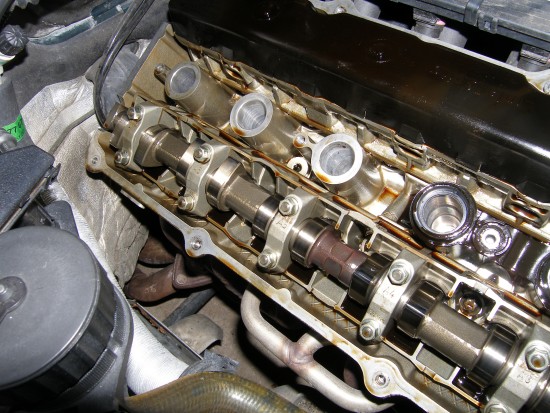Sunday, March 11, 2007
New Valve Cover Gasket, Plugs and Boots
The odometer crept over 140K last week, so yesterday I did a bunch of work including spark plugs, coil boots and valve cover gaskets. I'm planning to write up a DIY or two on these processes, but as usual I'll point out the highlights here.
First of all, the plugs were in pretty good shape for being in service 72K miles. They probably could have stayed in the car another 15K miles or more, but my tech said he recommends replacement every 75K miles. I'd also noticed a bit of a roughness at idle lately that I figured was related to aging plugs so it seemed the wise thing to do now, especially considering the labor was shared among the other tasks I had planned.
 The typical problem with the coil boots is that the rubber insulation hardens
and cracks, causing arcing and misfires. After 140K miles in service the rubber
insulation was definitely harder than the new parts, but aside
from a little oxidation on the terminal ends they appeared to be in good shape.
I considered this a preventative maintenance effort, and I expect the new parts
to last the remaining life of the engine so I think it's money well spent.
The typical problem with the coil boots is that the rubber insulation hardens
and cracks, causing arcing and misfires. After 140K miles in service the rubber
insulation was definitely harder than the new parts, but aside
from a little oxidation on the terminal ends they appeared to be in good shape.
I considered this a preventative maintenance effort, and I expect the new parts
to last the remaining life of the engine so I think it's money well spent.
The real eye-opener, however, involved replacement of the valve cover gasket, which is actually a kit of three gaskets -- two smaller gaskets that seal the plug holes and a larger gasket that seals the perimeter of the valve cover. The gaskets are typically replaced when oil is seen in the plug holes, but I found my plug holes dry as the Sahara.
Given the amount of work involved I briefly mulled over the idea of postponing this task. In retrospect, however, I'm glad I decided to go ahead with it because when I removed the old gaskets I found them so dry and brittle they snapped like thin, hard plastic. In light of this, I now believe valve cover gaskets should be replaced every 125K miles on the M52 (and presumably other BMW engines as well). Whatever you do, don't wait until you see oil in your plug holes before you replace the gaskets.
The most pleasant surprise of the day was the absolutely stunning condition in which I found the top of the engine. The exhaust cam showed practically no wear at all, and the overall color of the engine was good. I saw no sludge or other deposits. If I needed any more proof of how important it is to do oil changes at a higher frequency than BMW recommends, this was it. I couldn't believe I was looking at the top end of an engine with 140K miles on it. If you don't believe me, take a look at the picture.
Cost Analysis and Conclusion
The dealer charges $275 ($50 parts/supplies and $225 labor) to replace the valve cover gaskets on this engine, The labor to replace the plugs and coil boots is the same, though it's hard to say what the dealer would have charged me to do the plugs and boots at the same time. I'm fairly sure my technician would have swapped the plugs and boots for me because it wouldn't have cost him any additional time. Thus, the low-end estimate would be $275 + the cost of the plugs and boots ($180), or $455. On the other hand, given the fact that the dealer has never given me any kind of discount for combining tasks, it's very likely I would have paid for the additional labor of approximately 1.5 hours or $160. This brings the total to $610.
The work effort took me 3:45 to complete, but if I include the many short rest breaks and unrelated work (like breaking in my new compressor) the total time commitment was closer to 5 hours. I was definitely taking my time here, so I'm sure the next time I do this I could cut that time down significantly.
Mileage: 140650, Parts $202, Labor Saved: $408, Parts Saved: $50



